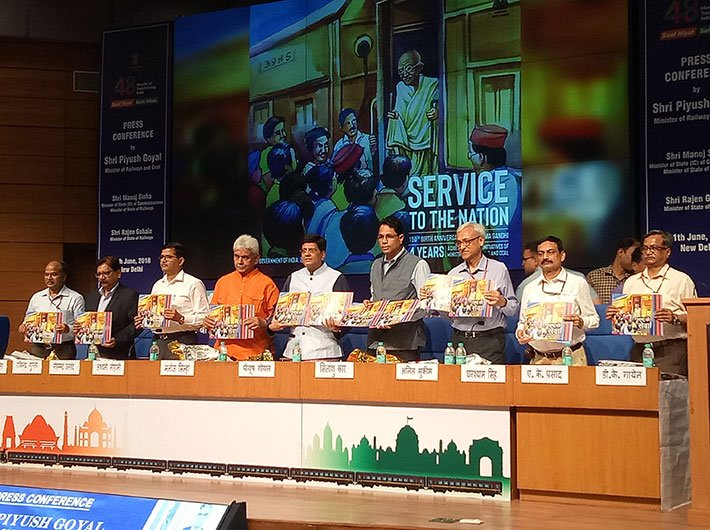Piyush Goyal blames lethargic attitude of the previous government for the slow development of rail infrastructure
Even as the union minister of railways Piyush Goyal claims of improving railways’ infrastructure and safety, Indian Railways still needs to put in massive efforts to curtail derailment accidents.
Contrary to the claims of Goyal, Indian Railways is still struggling to minimise derailments and accidents happening at the unmanned level crossings (ULCs).
According to railways’ statistics, 50 derailments took place between April and January in 2017-2018 compared to 53 derailments in a single year in 2013-14. The records show the railways did not make much progress in this particular sector where it should have worked proactively. Hundreds of lives are lost every year due to derailment caused due to manual and technical issues.
When the BJP government came to power in 2014, , 53 derailments occurred in 2014-15, followed by 63 in 2015-16, 65 in 2015-16 and 78 in 2016-17 which is a testimony to the fact that the railways did not do enough to ensure a safe ride for the passengers.
Ministry of railways in a reply to the Rajya Sabha disclosed that 327 train accidents occurred between 2014 and November 2016 in which 599 people were killed and 887 sustained injuries. Another report on safety and security in the railways showed that 421 people lost their lives in 857 derailments and 1,456 persons died as 610 mishaps took place at unmanned level crossings in the 11 years between 2005-06 and 2015-16. The data is enough to expose the tall claims of the railways of reducing fatal accidents.
In one such major incident, at least 23 people lost their lives after Puri-Haridwar Kalinga Utkal express got derailed at Khatauli in
Uttar Pradesh in August 19, 2017.
Derailments happen due to poor maintenance of tracks and negligence of ground staff which ignores routine repairing of rails.
However, the railways has of late started carrying out massive maintenance of tracks exercise which has resulted in poor
punctuality. Indian Railways has registered worst punctuality performance in three years.
The punctuality of trains is getting affected due to maintenance blocks to repair tracks. In 2016-17, 15 lakh maintenance blocks were given in 2600 areas in different sections which climbed to 18 lakh blocks in 4,400 locations. Goyal said safety would not be compromised irrespective of the poor performance of punctuality record.
Dozens of trains run many hours behind the schedule often to facilitate smooth passage of VIP trains like Rajdhani, Shatabdi, Duranto and other premium trains in which mostly affluent class people travel. Railways should also think about those who cannot afford expensive travel and can only afford average passenger trains. Such trains are several hours late. Many of such passengers often turn out to be students who often miss their competitive and academic exams when their trains run behind the schedule.
In a recent interview to Doordarshan, chairman of the railway board, Ashwani Lohani had rebutted reports of trains running late by many hours across the country. Lohani said that trains running from the northern to eastern parts of the country are getting delayed because of maintenance issues.
The second area where the railways need to work is the failure of its staff in accidents. As against the 51 accidents which had happened due failure of rail staff in 2013-14, 35 such mishaps took place under the BJP regime in 2017-18.
While charting out four years achievements of the railways, Goyal on June 11 squarely blamed the previous political dispensation for the poor infrastructure growth of the national transporter.
After being asked about how the railways is striking a balance between harbouring a dream of having India’s first bullet train and tackling with problems like poor infrastructure and 100 year old bridges, Goyal said the two things were not interconnected with each other. He said those who do not want to see India progressing technologically and getting its first high speed train are naysayers.
Interestingly, when the minister was asked about how the railway authorities kept ignoring the development of railways in the previous regimes, Goyal attributed poor flow of funds as the reason behind the railways shoddy progress.
Goyal listed out scores of good work done by the ruling government like improvement in safety record, increment in capital expenditure, commissioning of new lines, beginning of recruitment of 1.20 lakh safety employees, dedicated freight corridor and bullet train among others.
He said improvement of safety records is one of the biggest achievements. He said 118 accidents took place in 2013-14 which were plummeted to 73 in 2017-18. There has been a reduction of 62 percent in consequential train accidents in 2017-18, he said, adding that there has been 50 percent increase in track renewal from 2,926 kms in 2013-14 to 4,405 kms in 2017-18.

